Navigation
Install the app
How to install the app on iOS
Follow along with the video below to see how to install our site as a web app on your home screen.
Note: This feature may not be available in some browsers.
More options
Style variation
-
Congratulations MintJulep on being selected by the Eng-Tips community for having the most helpful posts in the forums last week. Way to Go!
You are using an out of date browser. It may not display this or other websites correctly.
You should upgrade or use an alternative browser.
You should upgrade or use an alternative browser.
Bridge collaspe in India 10
- Thread starter oldrunner
- Start date
- Status
- Not open for further replies.
Update:
Politicians like to panic, they need activity. It is their substitute for achievement.
Politicians like to panic, they need activity. It is their substitute for achievement.
The bridge is reported to have a span 750ft over the water. 300 people means each is over 2ft apart. That is a very light. A standard live load for any footbridge is 5kn/m2. This is approximately half a tonne or 1120 lb over 10.76 sqft. If every person is 2 ft from each other then there should be 5.625 person sharing 1120 lb design load resulting 200lb per person.
However every bridge has a safety factor for live load possibly 1.5 at least so the bridge should be good for 300lb per person standing 2 ft apart each other.
I haven't got the width of the footbridge but it can be 5 ft approximately. 750 ft x 5 ft is 3,750 sqft or 351 sq.m.. Thus at 5kN/m2 live load with 1.5 safety factor the bridge should be good for 2,6327 kN or 263 tonnes or 589,680 lb. Say an average Indian weighs 175lb then the bridge should be able to support 3,370 persons.
On conclusion I don't think the bridge has been overloaded but it might have been weakened, say corroded hangers or hanging connection points, resulting the renovated structure unable to carry its original design load. It is an old bridge recently renovated. The two main cable still hanging but some hangers seemed to have broken away from the deck.
This video shows the people testing the bride after it was opened. The bridge did not appear to be stable and yawed quite a lot. Also the deflected profile seemed excessive indicating the bridge might be in a poor state of repair. There was also scenes a pedestrian kicking the hanger violently while others were shaking the hangers.
However every bridge has a safety factor for live load possibly 1.5 at least so the bridge should be good for 300lb per person standing 2 ft apart each other.
I haven't got the width of the footbridge but it can be 5 ft approximately. 750 ft x 5 ft is 3,750 sqft or 351 sq.m.. Thus at 5kN/m2 live load with 1.5 safety factor the bridge should be good for 2,6327 kN or 263 tonnes or 589,680 lb. Say an average Indian weighs 175lb then the bridge should be able to support 3,370 persons.
On conclusion I don't think the bridge has been overloaded but it might have been weakened, say corroded hangers or hanging connection points, resulting the renovated structure unable to carry its original design load. It is an old bridge recently renovated. The two main cable still hanging but some hangers seemed to have broken away from the deck.
This video shows the people testing the bride after it was opened. The bridge did not appear to be stable and yawed quite a lot. Also the deflected profile seemed excessive indicating the bridge might be in a poor state of repair. There was also scenes a pedestrian kicking the hanger violently while others were shaking the hangers.
-
1
- #5
Another video shows the moment before the bridge collapse. The footage also show only left main cable left after the right main cable gave away. The fact the right cable wasn't seen after collapse is significant because of the failure could be at one of the two main cable of the bridge. Latest death toll is 141.
AFAIK wired cable has a safety factor of 6 to 7 and not easy to fail normally unless the cross section has suffered serious corrosion.
The bridge design seem to have a dynamic problem even if it is structural adequate. I remember the UK bridge design code BS5400 has warned the first natural frequency should be kept above 5 Hz as the vibration may be amplified by the walking tempo of the pedestrians. This bridge's vibration initiated by the pedestrians shaking is clearly a concern but probably not considered in its original design when it was inaugurated on 20 February 1879.
AFAIK wired cable has a safety factor of 6 to 7 and not easy to fail normally unless the cross section has suffered serious corrosion.
The bridge design seem to have a dynamic problem even if it is structural adequate. I remember the UK bridge design code BS5400 has warned the first natural frequency should be kept above 5 Hz as the vibration may be amplified by the walking tempo of the pedestrians. This bridge's vibration initiated by the pedestrians shaking is clearly a concern but probably not considered in its original design when it was inaugurated on 20 February 1879.
Here are some basic information of Morbi footbridge in Gujarat of India that collapsed on 30 Oct 2022.
From various youtube videos Some screen captures were provided below to show what is know so far.
Length 230-metre (750 ft) long
Width 1.25-metre (4 ft 1 in) wide
Built 20 February 1879 at time India was under British rule
Last Renovated 2022 and released to pedestrian traffic on 26 Oct 2022
Condition of footbridge before renovation showing deck's steel plates grossly deflected and worn out.
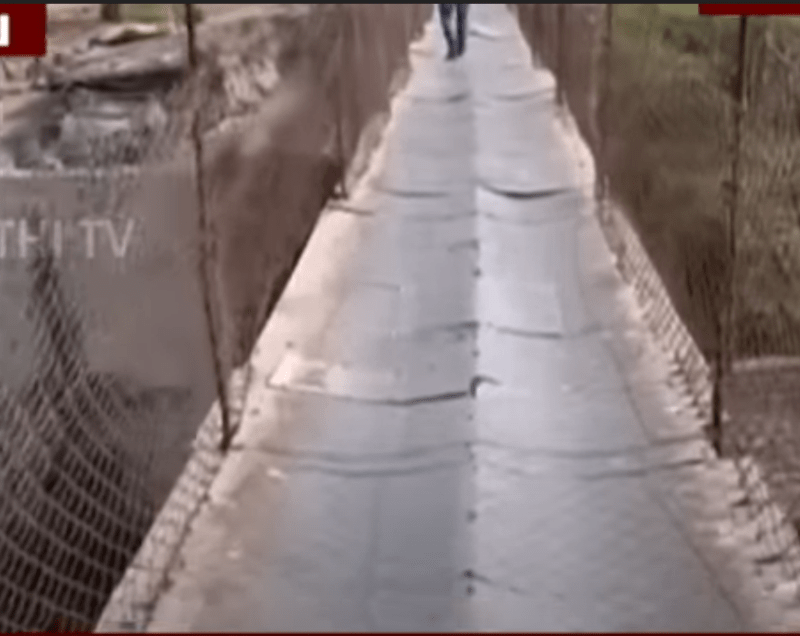
After opening to traffic pedestrians were seen shaking the kicking violently the hangers. The original video seems to have been removed possibly by the authority.
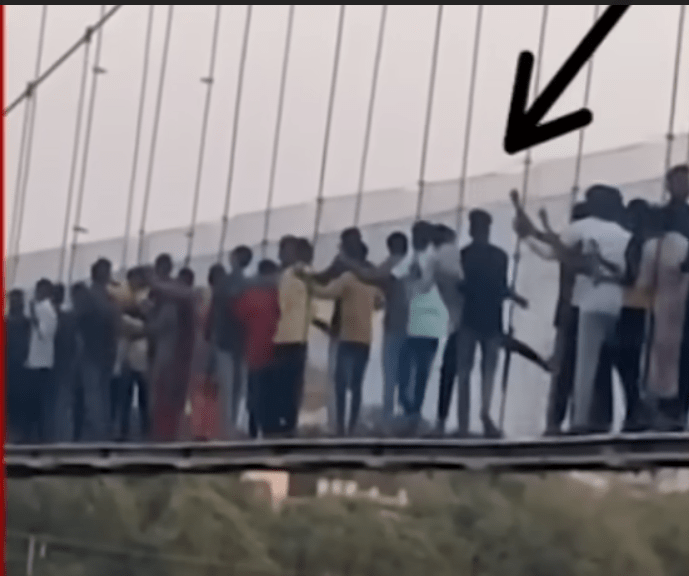
A few second prior to collapse people were bouncing and swinging at the deck
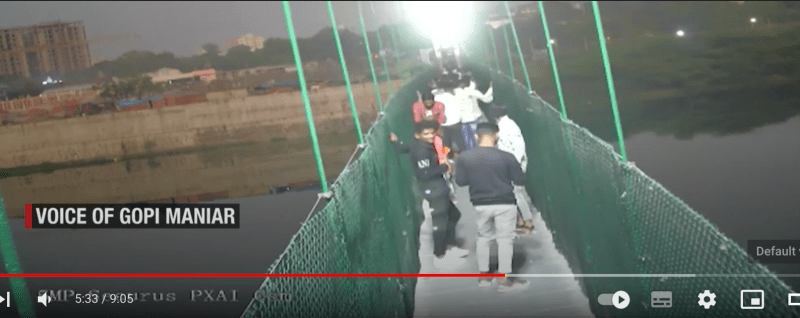
This picture depicts one main cable gave away during collapse
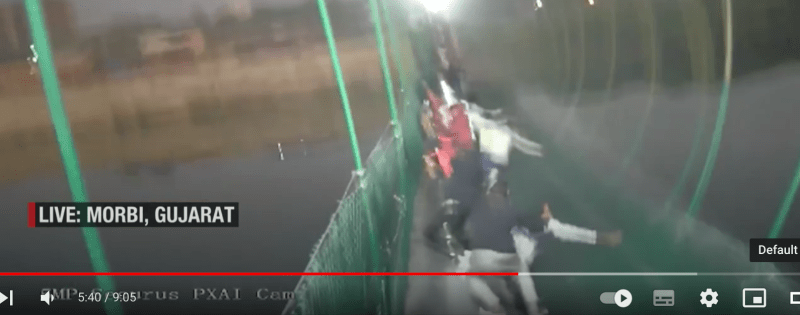
Remaining cable still hanging but the other side was clearly has gone missing
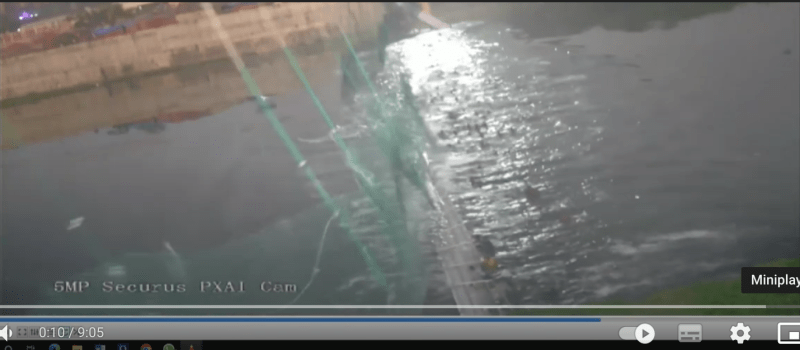
In the morning only one cable with empty hangers remained as shot was taken at the tower
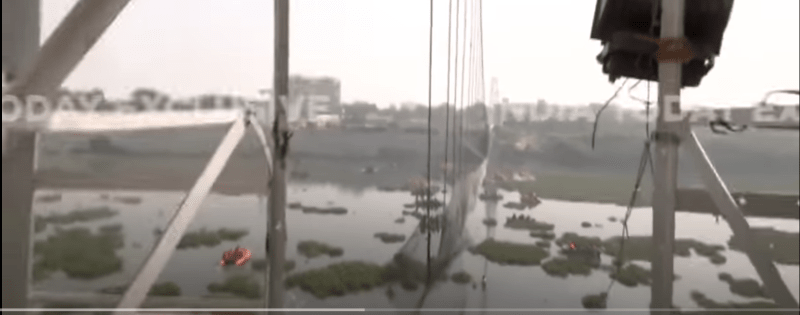
At the anchoring side span two cables could be seen but one was up while the other was down

An Indian journalist indicated this was the severed main cable. The position would suggest the cable might have broken off possibly at the top of the tower where the wheeled saddle joint would be located.
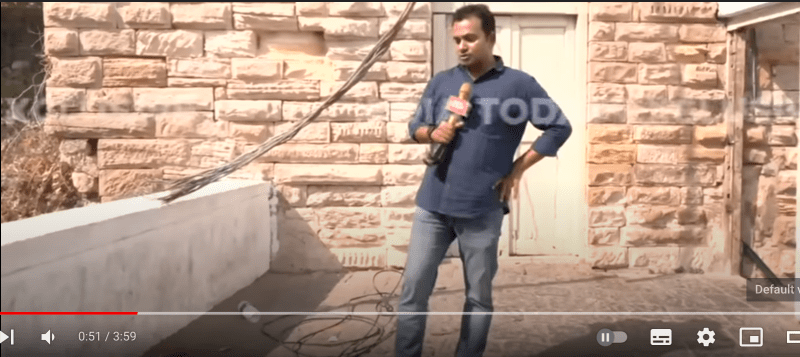
The tendons do show signs of tensile failure with necked ends indicating yielding took place at an excessive strain.
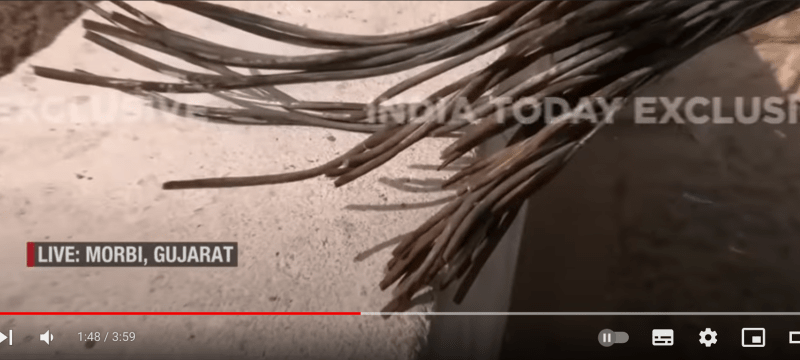
From various youtube videos Some screen captures were provided below to show what is know so far.
Length 230-metre (750 ft) long
Width 1.25-metre (4 ft 1 in) wide
Built 20 February 1879 at time India was under British rule
Last Renovated 2022 and released to pedestrian traffic on 26 Oct 2022
Condition of footbridge before renovation showing deck's steel plates grossly deflected and worn out.

After opening to traffic pedestrians were seen shaking the kicking violently the hangers. The original video seems to have been removed possibly by the authority.

A few second prior to collapse people were bouncing and swinging at the deck

This picture depicts one main cable gave away during collapse

Remaining cable still hanging but the other side was clearly has gone missing

In the morning only one cable with empty hangers remained as shot was taken at the tower

At the anchoring side span two cables could be seen but one was up while the other was down

An Indian journalist indicated this was the severed main cable. The position would suggest the cable might have broken off possibly at the top of the tower where the wheeled saddle joint would be located.

The tendons do show signs of tensile failure with necked ends indicating yielding took place at an excessive strain.

That is a modern phenomenon. The public likes to test anything that moves and vibrates to get high and to be cool. This also happened when the Millennium footbridge was opened in 10 June 2000 in London. That bridge vibrated sideways because it uses cables as the main support.
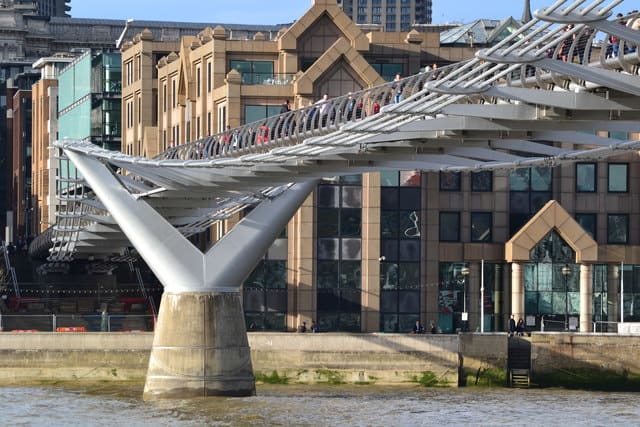
Londoners nicknamed it the "Wobbly Bridge" after pedestrians experienced an alarming swaying motion on its opening day. The bridge was closed later that day and, after two days of limited access, it was closed again for almost two years so that modifications and repairs could be made to keep the bridge stable and stop the swaying motion. It reopened in February 2002.
The modification was the addition of dampers to restrict the swaying motion that was previously amplified by the pedestrian traffic.
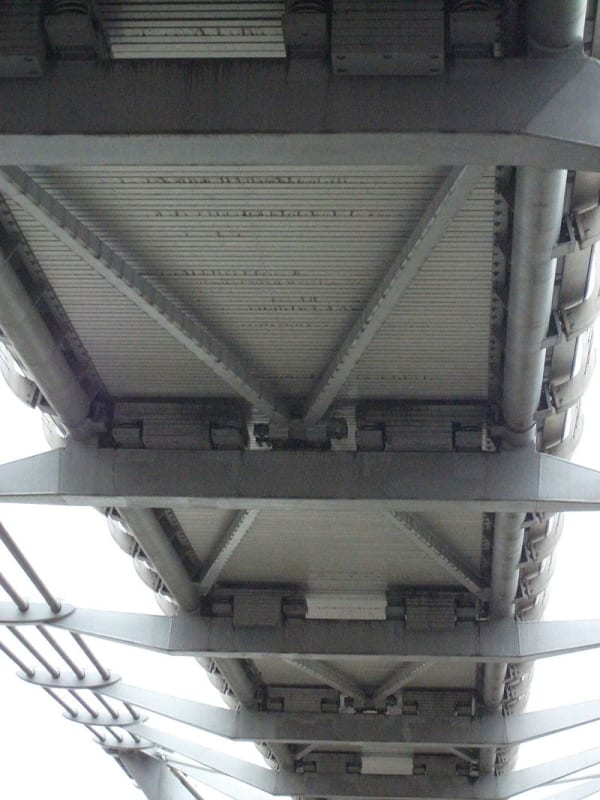
The difference between London's Millennium footbridge bridge and Gujarat's Morbi footbridge was the one in London was closed immediately on the same day it was opened. Morbi footbridge was opened on 26 Oct and collapsed on 30 Oct. Both were British designs but some 120 years apart.
Both were British designs but some 120 years apart.
This seemingly implies that disrepair and damage were not factors in the collapse.
TTFN (ta ta for now)
I can do absolutely anything. I'm an expert! faq731-376 forum1529 Entire Forum list
Actually my point is both of them vibrates!
BS5400 has warned the first natural frequency should be kept above 5 Hz as the vibration may be amplified by the walking tempo of the pedestrians. Although back in 1879 there was no BS 5400 for the designer of the Morbi bridge. Nevertheless a slender structure can be structurally adequate but can vibrate too if its structural dynamics is no addressed.
The bottom line is if there were no vibration there wouldn't have been people shaking, kicking, swaying and sloshing the structure to get high and to appear "cool" among their peers. Factually the bridge collapsed during the pedestrians encouraging and participating with the deck movements. If the bridge did not visually deflect but were steady as a rock there would be no fun when no movement could be made out of it no matter how hard one tried.
I have no knowledge of the last 143 years how the bridge was used. However any sensible person walks on a wobbly bridge and sees its deck condition. as I posted previously. would not want to mess around with this Morbi bridge. However if it has been newly renovated the local youths may think the bridge has been "fixed" and attempt to test it themselves without knowing their action could be detrimental to the structure.
-
1
- #12
spsalso - That's only true for what disrepair was in the contract for the construction company to repair. If replacing potentially corroded cables was not in the scope of the contract then that work would not have been done. It's possible that no one knew about corrosion within the cable hangers. Often times the cables need to be opened up look inside the multiple wires that make up the cables. This is very specific work done by only a few engineering companies worldwide.
Regards,
Qshake
![[pipe] [pipe] [pipe]](/data/assets/smilies/pipe.gif)
Eng-Tips Forums:Real Solutions for Real Problems Really Quick.
Regards,
Qshake
![[pipe] [pipe] [pipe]](/data/assets/smilies/pipe.gif)
Eng-Tips Forums:Real Solutions for Real Problems Really Quick.
LittleInch
Petroleum
It doesn't say what repairs were being undertaken, but I would hazard a guess it was only the deck structure and no one went to check the main cables.
If there was corrosion or breakage in the connecting clamps it may not have been spotted.
This from before hand.
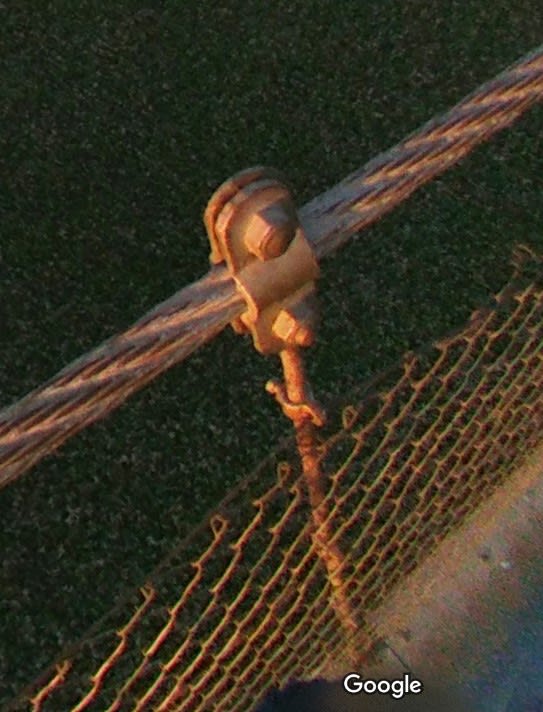
A more likely location would be the top of the towers though.
Remember - More details = better answers
Also: If you get a response it's polite to respond to it.
If there was corrosion or breakage in the connecting clamps it may not have been spotted.
This from before hand.

A more likely location would be the top of the towers though.
Remember - More details = better answers
Also: If you get a response it's polite to respond to it.
9 Arrested...
-----*****-----
So strange to see the singularity approaching while the entire planet is rapidly turning into a hellscape. -John Coates
-Dik
-----*****-----
So strange to see the singularity approaching while the entire planet is rapidly turning into a hellscape. -John Coates
-Dik
JohnRBaker
Mechanical
When I was in the Army, on several occasions we had to march across bridges, and it was mandatory that we proceed using 'break' or 'bridge' step. In essence, a cadence without a cadence.
John R. Baker, P.E. (ret)
Irvine, CA
Siemens PLM:
UG/NX Museum:
The secret of life is not finding someone to live with
It's finding someone you can't live without
John R. Baker, P.E. (ret)
Irvine, CA
Siemens PLM:
UG/NX Museum:
The secret of life is not finding someone to live with
It's finding someone you can't live without
LittleInch
Petroleum
Whilst a little imperfect this picture of the cable break shows what seems like a rust exterior with may of the cable elements broken with what remains looking very like a stretch to beyond yield. The lower strand has actually unwound so if you wound it back I think it would be pretty much level with all the other broken ends. I suspect this is either at the top of the tower or one of the first long vertical hangers. So it would look like about 2/3 of the wire core had already snapped before the events of the reopening took its toll.
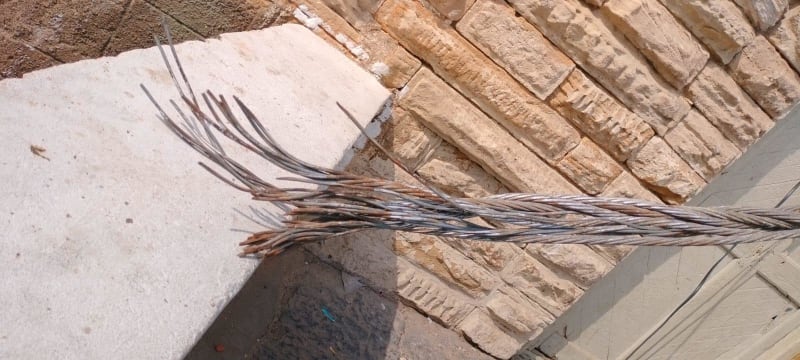
Remember - More details = better answers
Also: If you get a response it's polite to respond to it.

Remember - More details = better answers
Also: If you get a response it's polite to respond to it.
-
1
- #18
Just some more easy information with photos on this collapse. The information would support the south main cable has severed and is now resting between the west tower and a masonry wall.
Here is a screen capture of the Google Map. It appears the west side has a dry beach area but the east side has water flooded to the boundary wall.
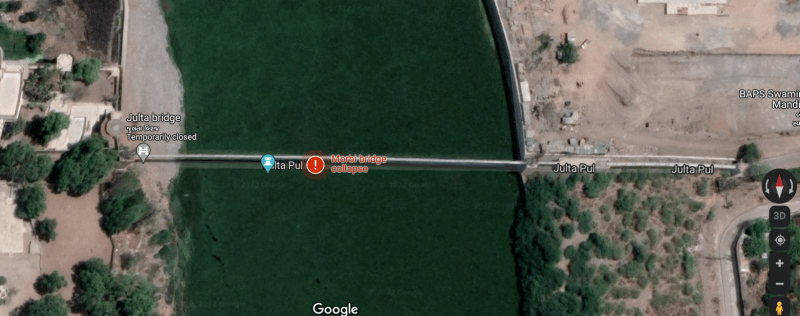
Therefore this is the west side as it has a dry beach. The south side main cable is missing. The one left is the north main cable. Note behind the steel tower there is a large masonry wall. The west side after collapse also had no deck structure attached.
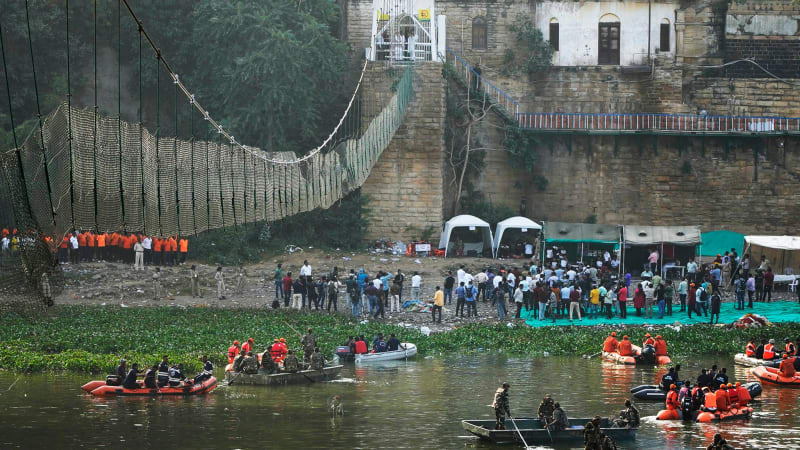
This is a screen capture at the west tower before renovation. Behind the tower there is a large masonry wall with a white door, some ornamental columns at the top of wall. Looking through the tower steel work there is a white parapet wall between the west tower and the masonry wall.
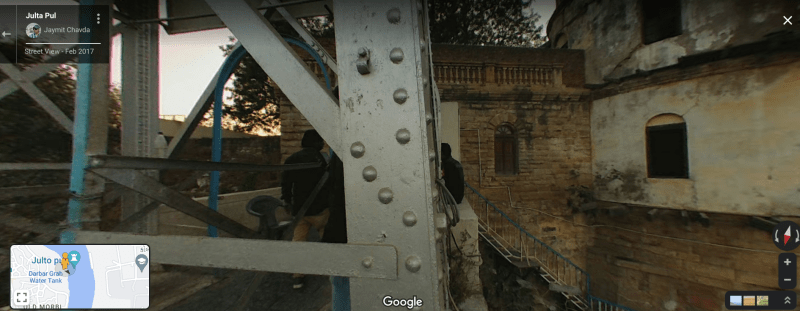
Thus with the masonry wall background we can establish the south side main cable has snapped off
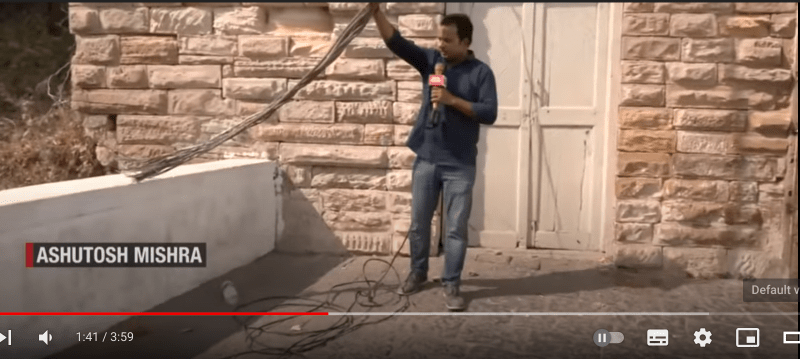
The ornamental columns at the top of the masonry wall confirm this is the west side and the south main cable is down whereas the north side cable is still up in the air on the tower.
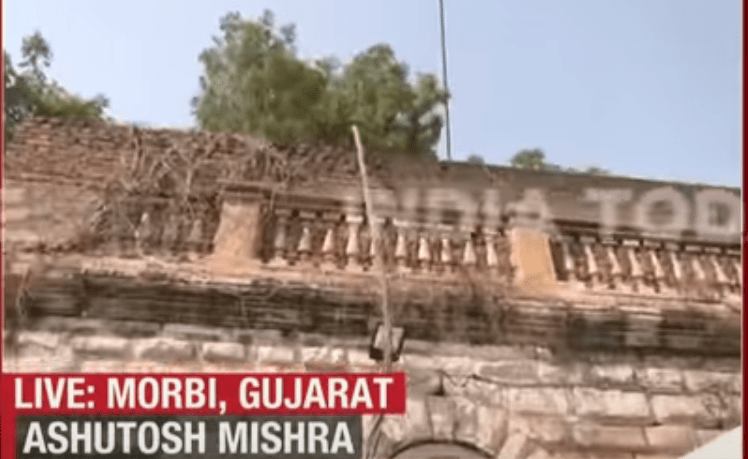
This is the side view of the bridge before renovation. The tower is a lattice steelwork. The middle span, that crosses the river had vertical hangers and the main cables are in a catenary profile. The side span, that is at the back or on the shore has no henger because it is not needed but the main cable in this section is a straight line. The white parapet wall is also visible in the photo.
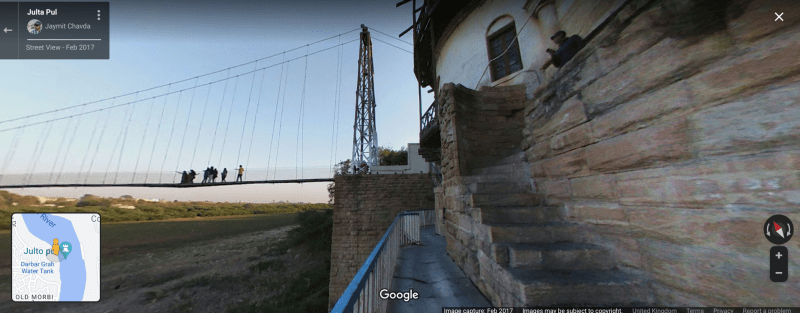
---------------------------------------------------------------------
Now the east side
This is the east side. It has a broken deck still attached. Two main cables are still visible attaching to the twisted deck. Its side span has hangers and there is no masonry wall behind the tower.
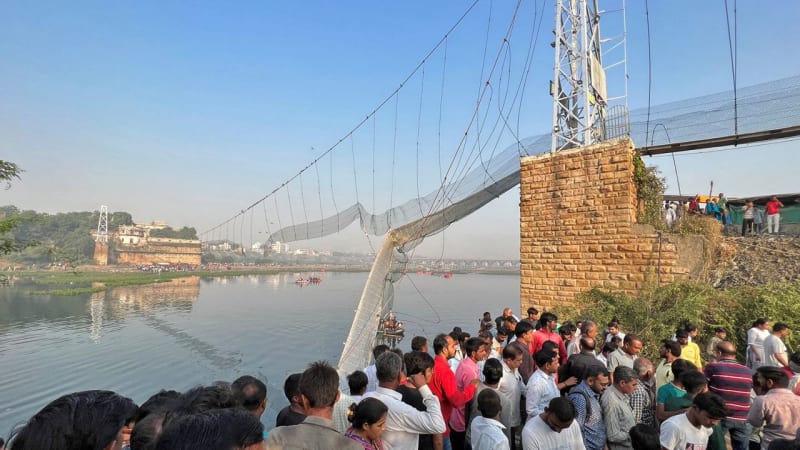
A front elevation of the East tower showing no masonry wall behind the tower and the water flooded to the boundary wall without any dry beach area. Two cables can be seen still attached to the tower.
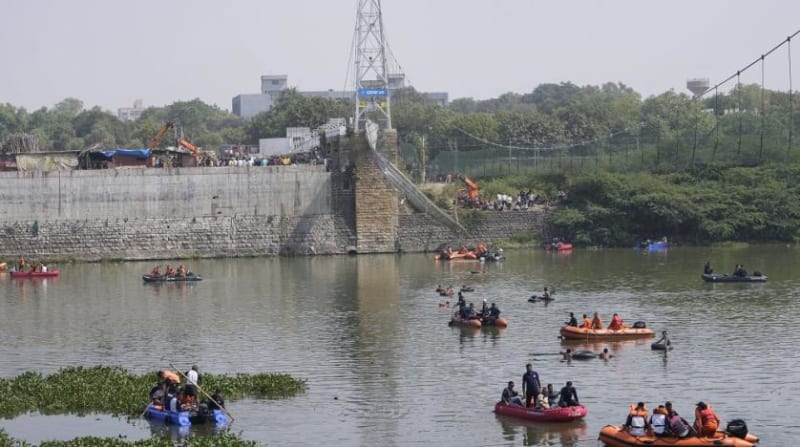
Here is a screen capture of the Google Map. It appears the west side has a dry beach area but the east side has water flooded to the boundary wall.

Therefore this is the west side as it has a dry beach. The south side main cable is missing. The one left is the north main cable. Note behind the steel tower there is a large masonry wall. The west side after collapse also had no deck structure attached.

This is a screen capture at the west tower before renovation. Behind the tower there is a large masonry wall with a white door, some ornamental columns at the top of wall. Looking through the tower steel work there is a white parapet wall between the west tower and the masonry wall.

Thus with the masonry wall background we can establish the south side main cable has snapped off

The ornamental columns at the top of the masonry wall confirm this is the west side and the south main cable is down whereas the north side cable is still up in the air on the tower.

This is the side view of the bridge before renovation. The tower is a lattice steelwork. The middle span, that crosses the river had vertical hangers and the main cables are in a catenary profile. The side span, that is at the back or on the shore has no henger because it is not needed but the main cable in this section is a straight line. The white parapet wall is also visible in the photo.

---------------------------------------------------------------------
Now the east side
This is the east side. It has a broken deck still attached. Two main cables are still visible attaching to the twisted deck. Its side span has hangers and there is no masonry wall behind the tower.

A front elevation of the East tower showing no masonry wall behind the tower and the water flooded to the boundary wall without any dry beach area. Two cables can be seen still attached to the tower.

Some interesting information in section Accusations ove repairs:
Considering the "severed" cable end, I'd point my finger squarely at the restoration process as the failure point.
If I ever see an engineer put a note "client shall not vibrate structure" on their drawings, I will push for their removal from a project.
If I ever see an engineer put a note "client shall not vibrate structure" on their drawings, I will push for their removal from a project.
- Status
- Not open for further replies.
Similar threads
- Replies
- 0
- Views
- 3K
- Replies
- 0
- Views
- 6K
- Replies
- 334
- Views
- 91K
- Question
- Replies
- 27
- Views
- 28K
- Replies
- 2
- Views
- 8K
